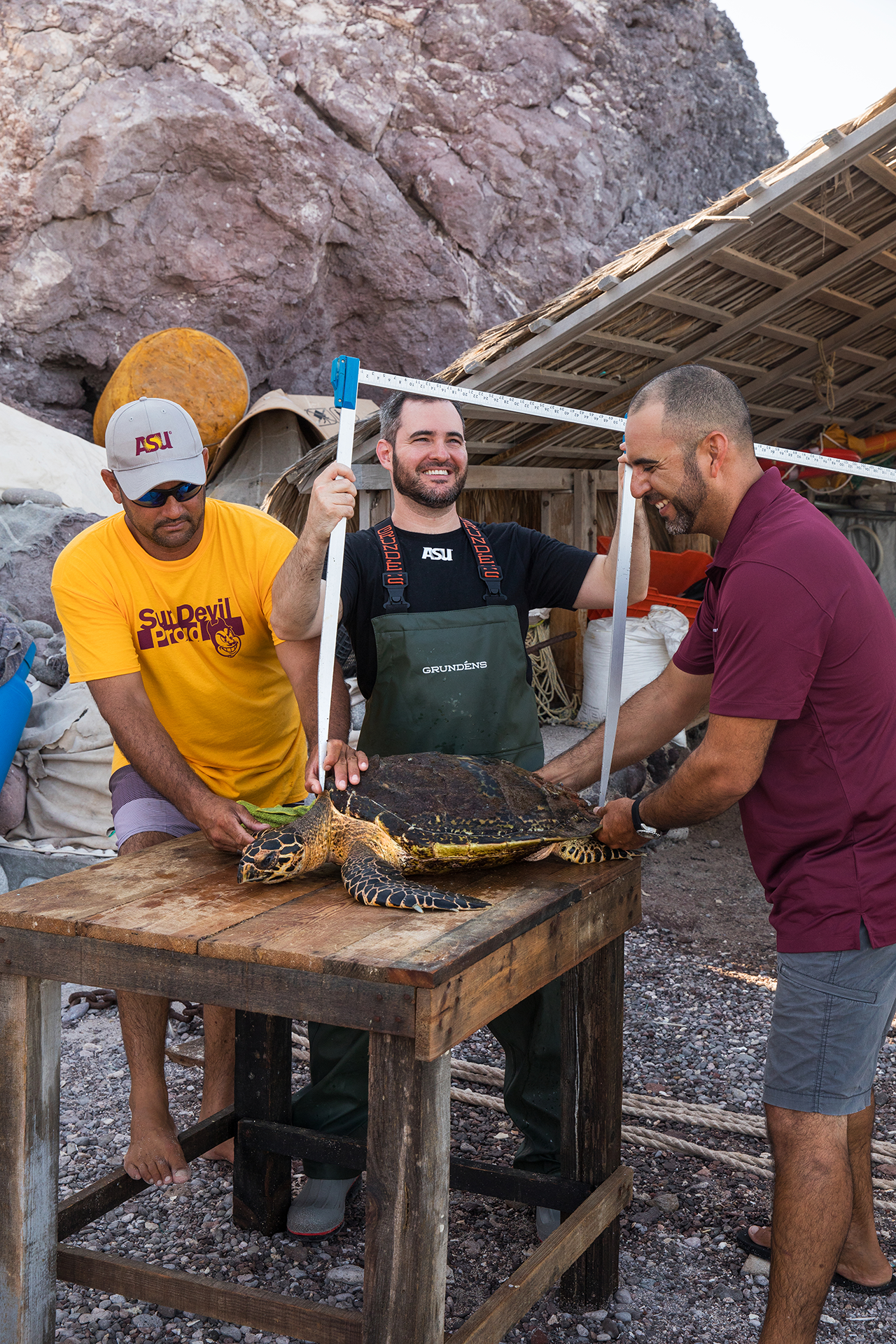
Net Worth
To save the sea turtles, says alum Jesse Senko, you first need to help the fishers whose very nets entangle them ...
By Lisa Stiepock
Photos Contributed By Arizona State University

Jesse Senko (center) and brothers Felipe (left) and Juan Cuevas measure a rare hawksbill turtle (above). Fishing nets around the Cuevas' tiny island of El Pardito in Mexico could accidentally snare hundreds of sea turtles every month. Then Senko arrived.
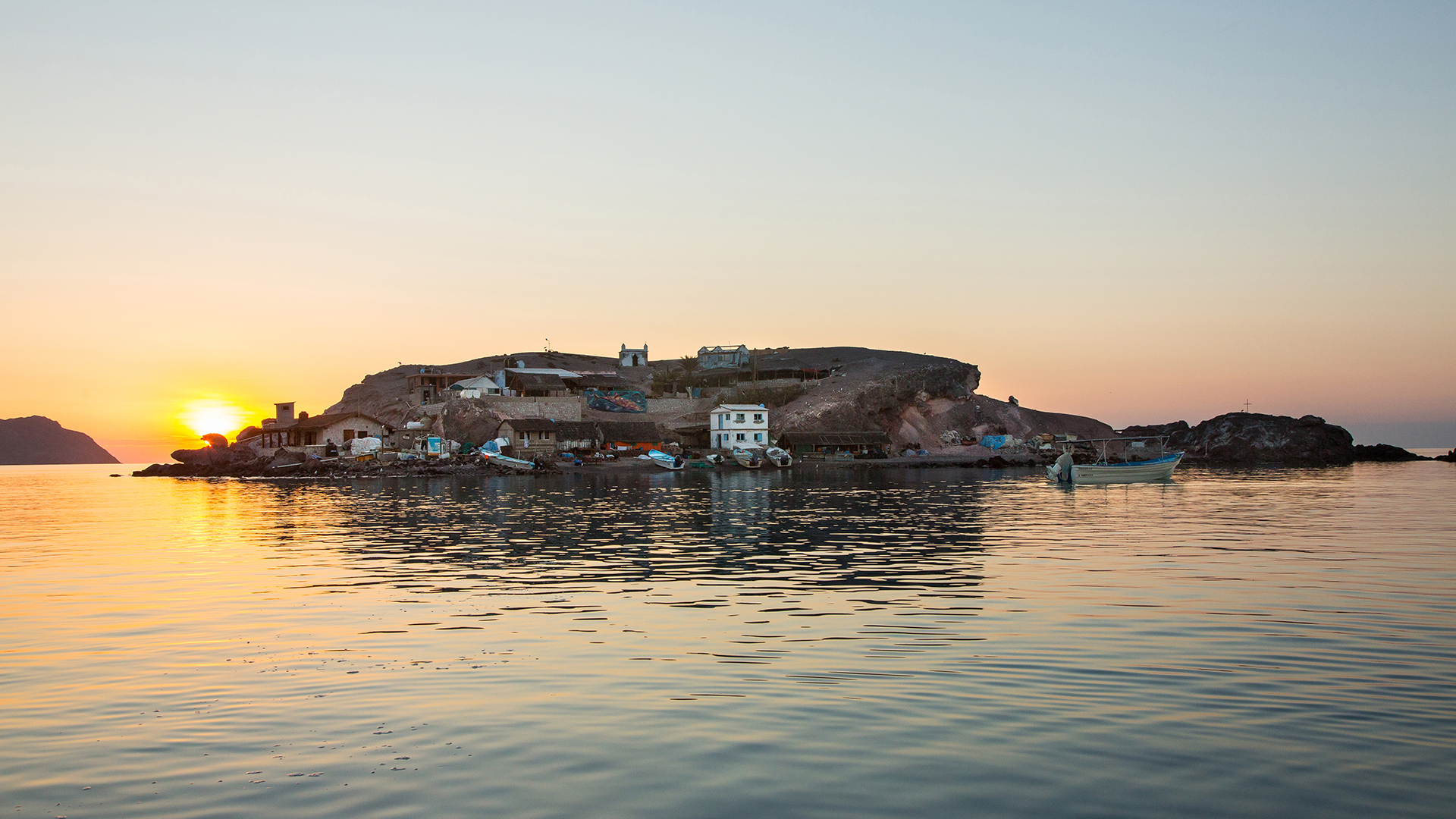

"I did what any 12-year-old boy would do — I latched onto the thing," says Jesse Senko '06 (CAHNR), recounting the time a "gigantic" green sea turtle
swam up to him while he was snorkeling in the Cayman Islands with his family. "I remember hearing the screams from my mom on the boat. She was terrified. She's screaming. And the crew's blowing whistles. And they're yelling. And I remember thinking, 'Screw it. I'm going on this ride.'"
Eventually the turtle brought Jesse back to the boat. But the ride never ended.
Even as Jesse's parents were yanking their delinquent out of the water, he was sputtering, "Now I know what I want to do with my life. I want to study sea turtles." Of course they laughed. "They were like, 'Oh my God, that's so cute.' I mean, they didn't discourage it. No, no," says Senko. "But they were thinking, Yeah, that's today."
Two decades and three university degrees later, Senko is still obsessed with sea turtles. His signature laser focus, though, has shifted from the sea turtles themselves to the fishers who unwittingly tangle sea turtles and other bycatch in their gill nets.
And to two fishers in particular. Brothers Juan and Felipe Cuevas live off the Baja California peninsula on Isla el Pardito, which is believed to be the smallest island in the world inhabited year-round by a single family.
"It's a rock," says Senko. "It's basically a two-acre rock in the middle of the Gulf of California." A three-hour small-boat ride from the coast, there's no sign of civilization in any direction— just other islands, all uninhabited. The family has been on this rock for more than a century — legend has it they drifted there in a storm.
Senko met Juan and Felipe in January 2018 in Baja at a conference. "The moment you meet them, you're like, OK, these guys really know what they're doing. They're going to be leaders in the community, they're going to get other fishers to adopt new technologies. They have that 'it' factor. I knew I wanted to work with them."
Speaking of the 'it' factor — by the time this fateful conference rolled around, Senko had become a bit of a wunderkind among turtle people. Since graduating from UConn in 2006, he'd had the big "aha!" research moment (determining that turtles will avoid nets if they know the nets are there); devised a solution (nets are deployed at night when they can't be seen, so attaching battery-operated lights makes them visible to turtles and other larger marine animals who then avoid them); tested that solution (the lights reduced bycatch by a stunning 50% for turtles and 95% for sharks and rays — without affecting target catch); identified the fatal flaw with his solution (paying for and changing out the lights' AA batteries every few weeks — hundreds per net — is decidedly prohibitive); and come up with a potential fix (make the lights solar powered).
And, as luck would have it, the marine scientist who found himself needing to invent a solar-powered device was now teaching marine sciences at Arizona State University (ASU) — far from any ocean but home to some of the country's most innovative solar engineers.
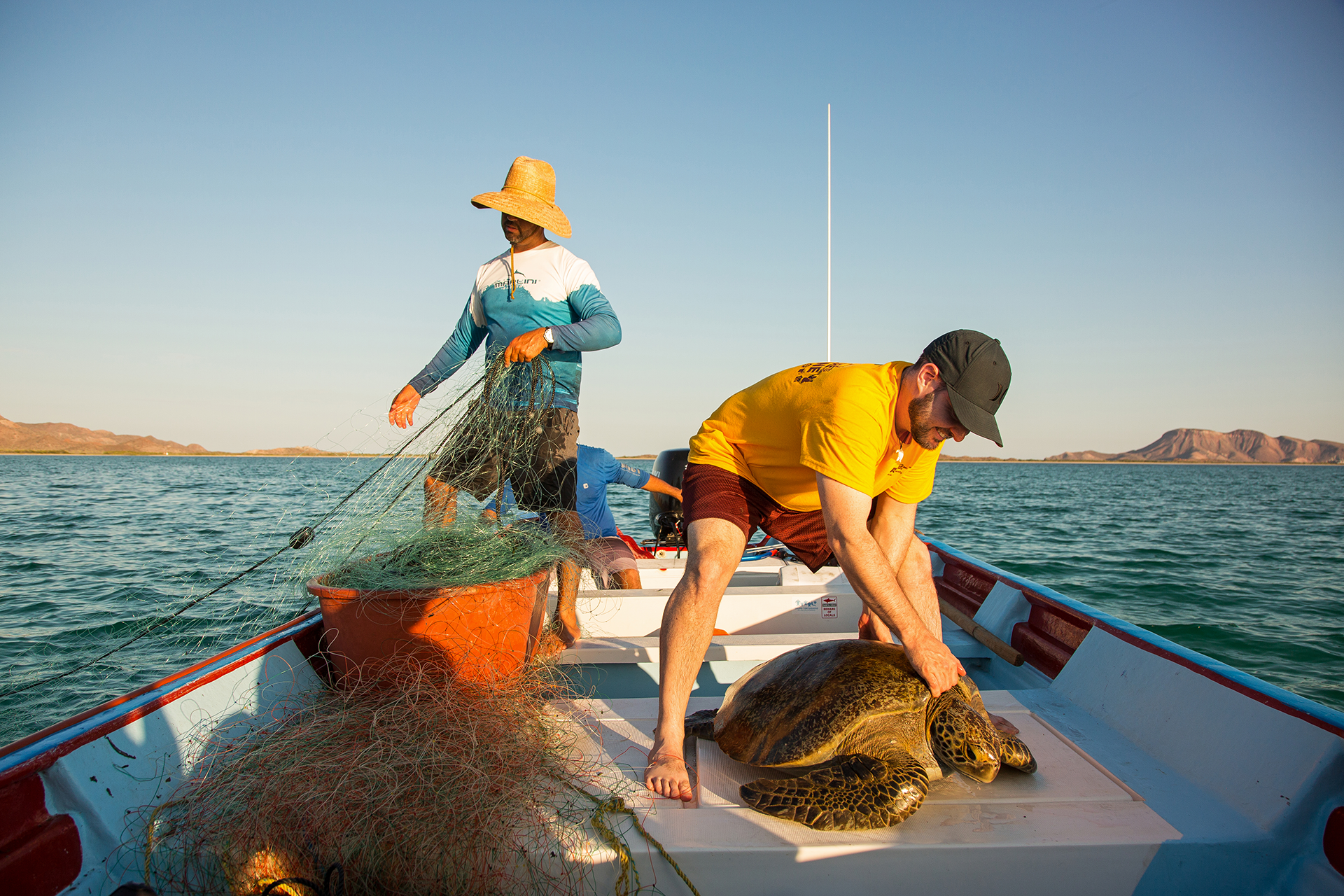
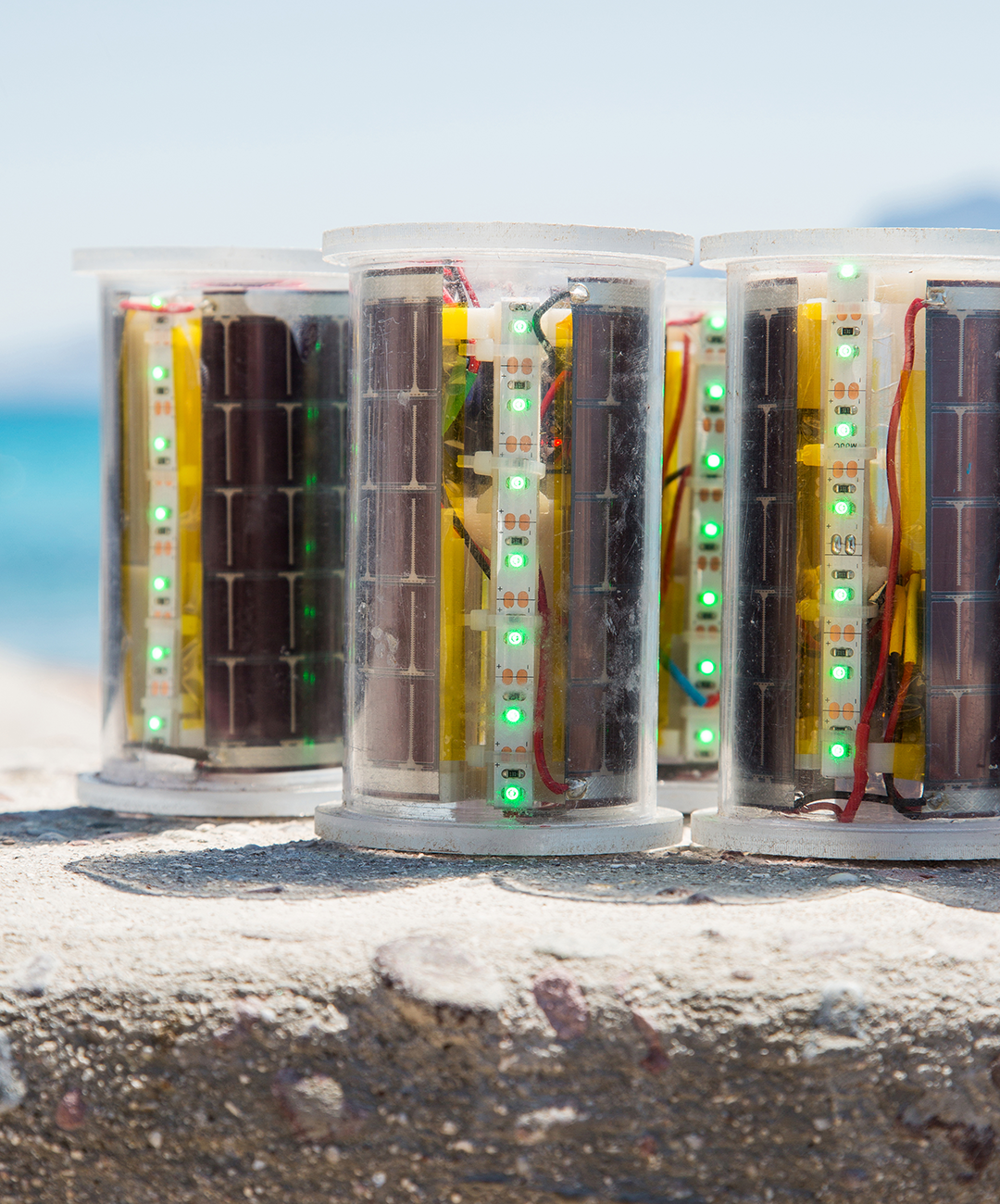
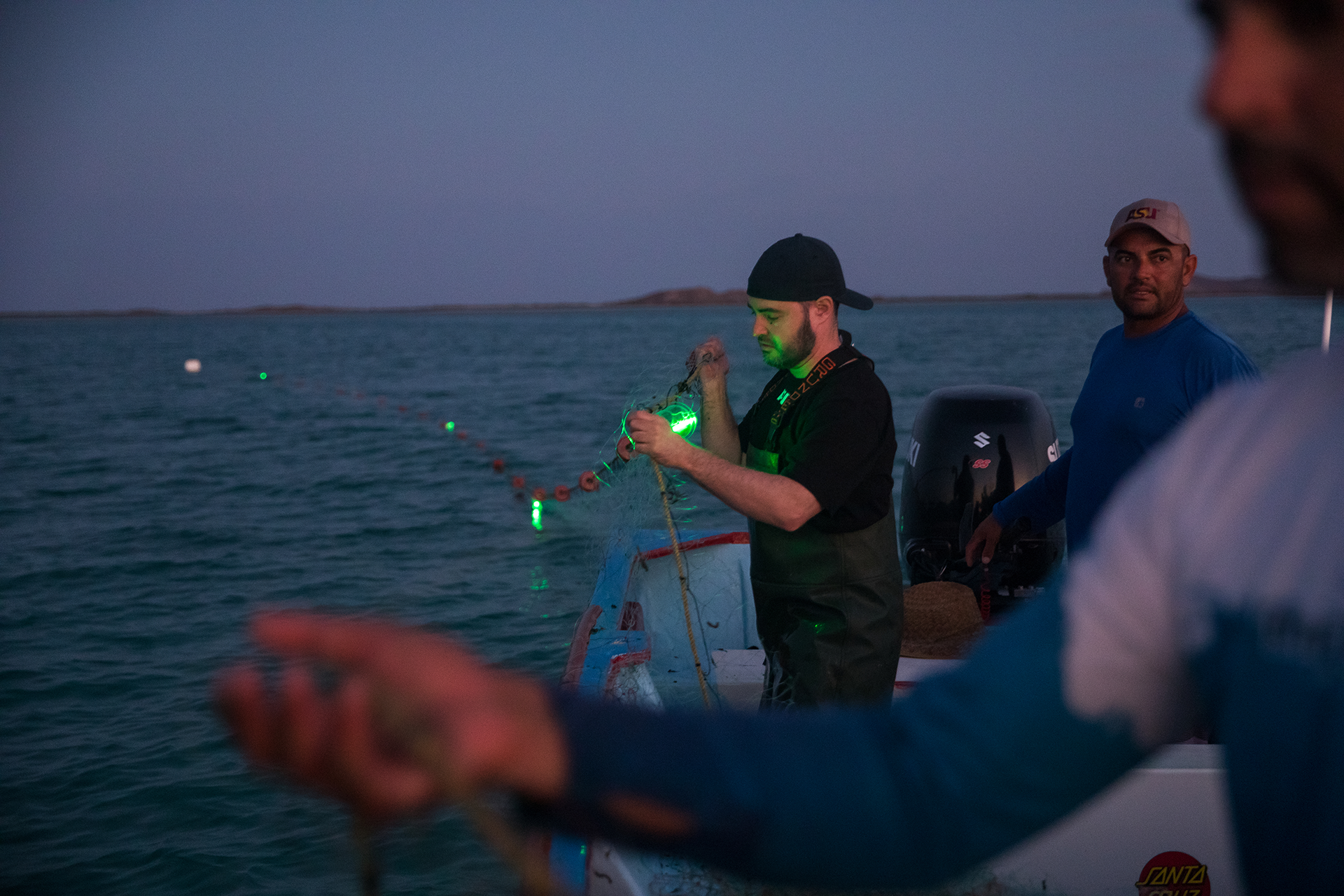
Senko worked with the Cuevas brothers to design these lighted buoys that help steer sea turtles (like the green sea turtle above), sharks, and rays away from gill nets. After nearly six years of fishing with the buoys and helping Senko's team collect data, Juan Cuevas says, "We want to learn how to read the results of scientific studies so we can teach conservation to other fishing communities in our region."
Buoyed
Senko and a team of ASU solar engineers, who were excited to work on a sea turtle project, traveled to Baja to talk with the brothers and other fishers about their plan to design solar-powered lights that would hang from fishing nets as the battery-operated lights had. "I was five minutes into the first meeting," recalls Senko, "and Juan raises his hand and says, 'Why don't you just make a lighted buoy?'"
Senko loves this story because it illustrates so well how important it is to listen to the community that will need to implement your conservation ideas, the people whose livelihoods will be most affected. The Cuevas brothers were thinking about how they would fish with the lights and knew they'd rather not deal with an extra piece of equipment, one that might weigh their nets down. They already needed buoys, so why not make lighted ones that would seamlessly integrate into their gear?
Senko and his team stopped working on the hanging solar lights and started designing buoys.
Once they had enough lighted buoys manufactured, they gave them to Juan and Felipe to test and then return to ASU. But the brothers asked if they could keep the buoys and Senko agreed, provided they'd keep testing and collecting data. For almost six years now the Cuevases have been fishing with solar-powered, illuminated nets.
"They're using the most sophisticated gill net technology on the planet," says Senko. "You would think that these big Chinese or Japanese fleets would be doing it, but no. It's this little family that lives on a rock in the middle of the ocean. And they are reporting that they barely catch sea turtles anymore."
Juan concurs: "So far Jesse's lights have worked great. They make fishing easier for us because we aren't spending as much time removing bycatch from our nets. And they work really well at keeping turtles away. We rarely catch turtles when we fish with the solar-powered buoys."
This has more impact than you might imagine. "I'm guessing we've saved thousands of turtles from just these two fishers," says Senko. "On a typical day, a fisher in that region may catch as many as four to eight turtles. So if you start doing the math, that's a lot of turtles." We did the math. Conservatively, 4 turtles × 300 days × 5 years = 6,000 turtles! But Senko continues. "I also like to look at it in terms of turtle years. So each one of these four turtles fishers are catching is on average 20 to 30 years old. So you're talking, you know, 80 to 120 turtle years per day, on the low end, that could be removed from the environment." Sea turtles typically live 50 to 100 years.
"Being a part of this project has really shown us how interconnected everything is, and how the impacts of bycatch in El Pardito can affect ocean ecosystems in other parts of the world," says Felipe. "The solutions we are developing with Jesse can be used anywhere in the world — to save turtles but also to make it easier for fishers to fish."
Indeed, if Senko and his team can produce these lighted buoys cheaply enough — which is precisely what they are working on now — it's hard to imagine any gill net fisher not wanting to use them. According to Senko, not dealing with those unwanted — and in the case of sea turtles and some sharks, environmentally protected — species makes life easier for fishers in three key ways: It gives them more time, better health, and a higher quality product to sell.
More Time: Lighted nets mean less bycatch means less time hauling and sorting and less weight to pull. "First of all, turtles and sharks are really hard to remove from nets; sometimes they just have to cut them out. And big animals like turtles — who average 100 pounds each — create a lot of hydrodynamic drag on the net, which makes it harder to pull. We've found that the lighted nets can save fishers 55 to 70 minutes a day. So that's a big one. I mean, it's time, right? Everybody wants more time. It's the most valuable resource."
Better Health: Lighted nets mean less bycatch means less weight to haul and sort. "Pulling nets is really hard in the Pacific, and a lot of these guys end up being unable to fish past their 50s or 60s because it's just too hard on their backs. So you're making it easier for them and potentially extending their careers. Imagine you're on an 18- to 20-foot boat and you have four to eight 100-plus-pound turtles in your net every single day. It's just an enormous amount of work to get them out of the net, to lift them up, to put them back into the water."
Higher-Quality Product: Lighted nets mean less time out on the water means the catch gets to shore faster. "Small scale fishers often don't have the capacity to ice their catch. They typically don't have ice in their homes. So they're working against time. Not having to struggle with unwieldy turtles, sharks, and rays means that as soon as they pull their nets up, they head right to shore. And there's a middleman with an ice truck waiting, right? So you've got a higher quality product."
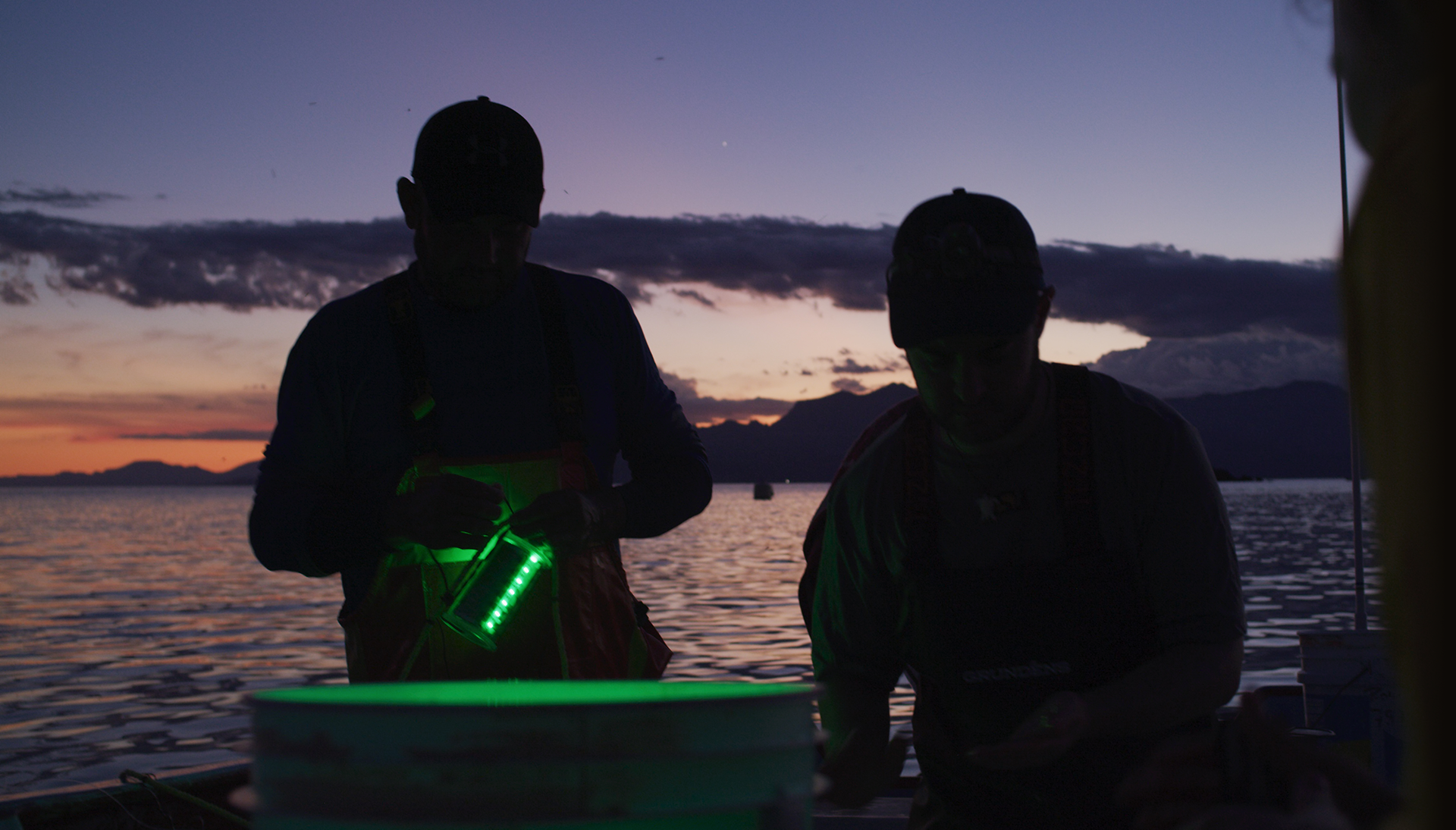

"Turtles fill unique ecological roles," says Senko. "There's a reason they've been around for 100 million years — they are good at what they do." For example, green turtles are herbivores who graze and keep seagrass healthy; hawksbills feed on sponges, which helps keep coral reefs healthy; and leatherbacks are nature's way of controlling jellyfish populations.
Senko, here with a leatherback turtle, says his hands-on teaching style is continually informed by his choice of an applied science major at UConn — fisheries and wildlife.
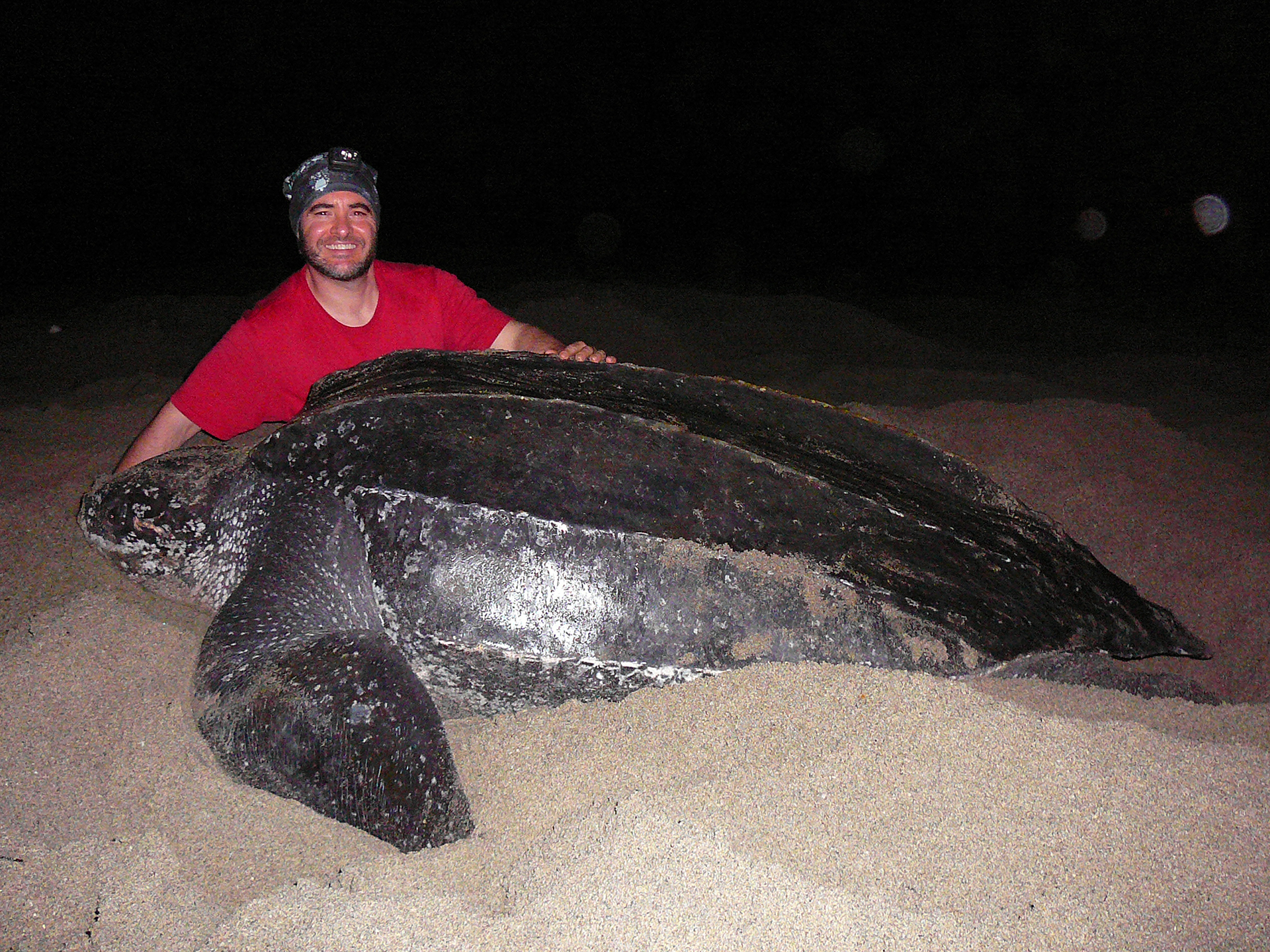
Script Flip
For years Senko was all about saving the turtle, but he's come to realize that helping fishers is the best way to help turtles. "We flipped the script," he says. "We've gone into these communities and we've basically said, 'How can we make your fishing easier? How can we make your fishing more efficient? You're still getting the reductions in turtle bycatch, but it's approaching it from a different standpoint. I think that is what's really innovative about our work."
The data from El Pardito proves the point. Senko's original research with the battery-operated lights showed fishers caught 50% fewer sea turtles in their nets and 95% fewer sharks and rays. In the past six years, the Cuevases found a similar reduction in shark and ray bycatch, but sea turtle bycatch has been reduced by 65%
"I think the most gratifying thing about this project is just how much Jesse involves us in the study," says Juan. "We have worked with scientists before, but usually we are told what to do and how we can assist their research. But with Jesse it's been completely different — we work together to design the technologies we want to test, and then we also work with Jesse to design the experiments. And you know, that makes us feel like we are truly part of the team. A big thing for us is, How can we fish more sustainably? The solutions we are testing with Jesse give us hope for a future where we can fish better and preserve the balance of life."
The brothers say they and the rest of their family love showing the island to Senko's students, who come every spring to collect and sort data.
One of those students, Ryan Keating, after a day spent swimming with sea lions and whale sharks and watching the Cuevases and researchers "doing the work," echoed his professor's childhood experience. "We had journals to keep track of our thoughts throughout the trip." At the end of that day, he says, "the final thing I wrote was, 'I will become a marine biologist.'" The students in turn inspire the fishers.
"I want my children to fish but after working with Jesse, I also want them to go to school. I want them to learn about the ocean and maybe become scientists like Jesse," says Felipe.
"We rarely catch turtles when we fish with the solar-powered buoys."
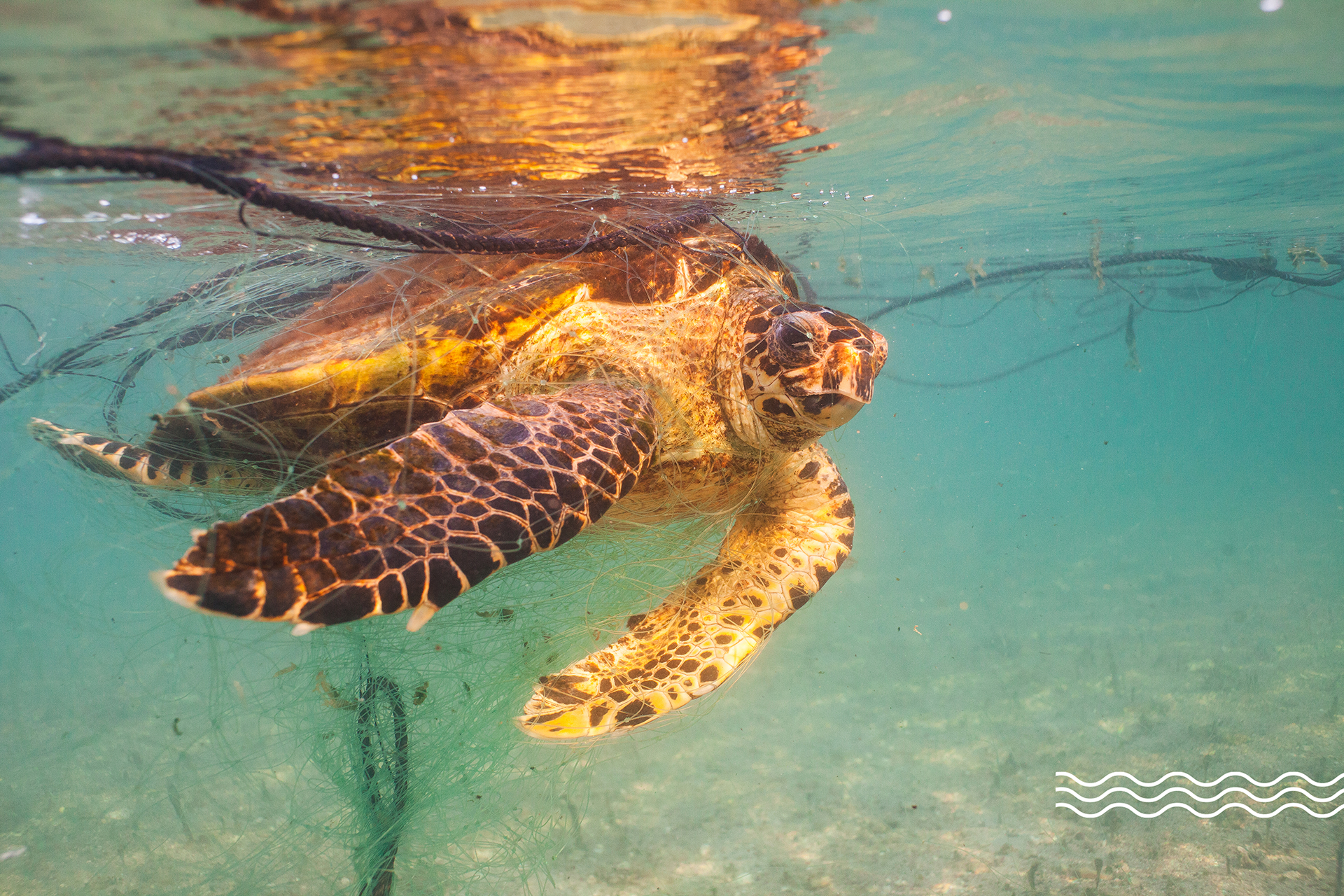

Senko's study-abroad students weigh an adult hawksbill turtle. The spark for the illuminated gill nets project came to Senko when he was working on a research project for his own master's in Mexico. He was tracking sea turtles in the middle of the day: "This turtle swam up to a gill net and right before it was going to hit the net it made a complete U-turn. And I realized if the turtle sees the net, it may avoid the net."
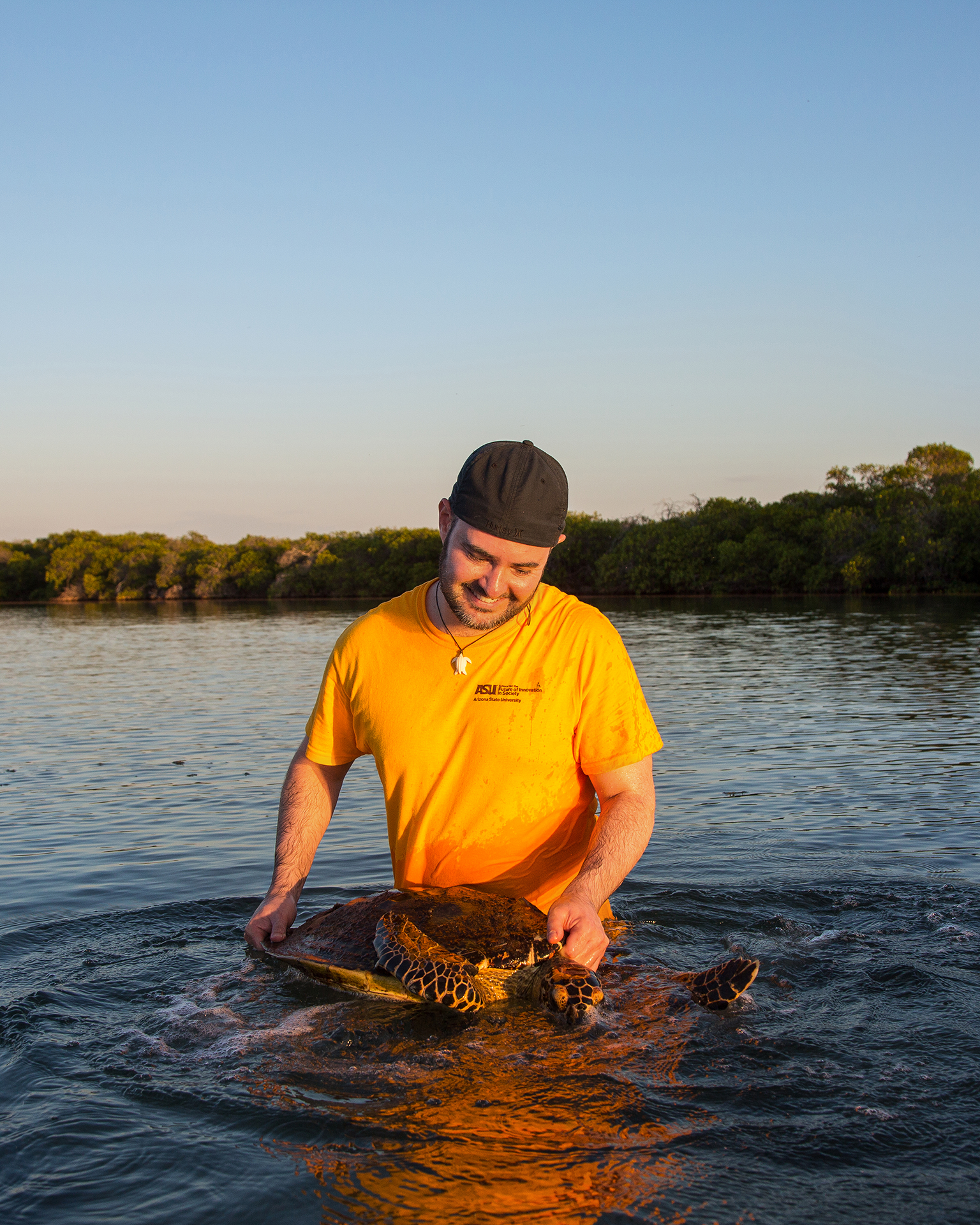

Wow. Thank you Jesse Senko.